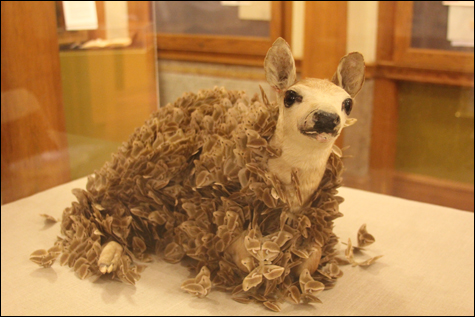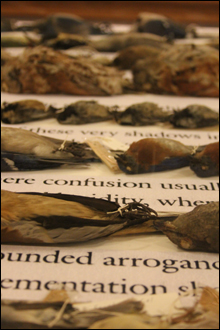
MAGIC AND ROT Raimondi's Comfort.
|
The exhibit "Curiouser: New Encounters with the Victorian Natural History Collection" in the lobby of the Museum of Natural History (at Roger Williams Park, 1000 Elmwood Avenue, Providence, through September) takes as its title Alice's exclamation of surprise early in her adventures down the rabbit hole in Lewis Carroll's 1865 novel Alice's Adventures in Wonderland. For curators Erik Carlson and Erica Carpenter, the line describes the magic and oddity of Victorian natural science that the museum embodies, and that they've invited six artists to plumb.

MOURNFUL Antonsen's Describing the Shadows. |
During that era in the second half of the 19th century, public museums grew out of private collections generated by Western political and mercantile empires that shipped man-made and natural treasures back from explorations of distant and (to them) exotic lands. These explorations spawned society-transforming ideas, like Charles Darwin's theory of evolution, which he first published in 1859, as well as business as Westerners exploited foreign resources.As the artists here dig through the museum's 250,000 specimens for inspiration, the obsessive killing and collecting of Victorian natural science seems both wondrous and creepy, and a harbinger of the environmental threats facing us today because of our treatment of the Earth.
Jennifer Raimondi's Comfort is a tiny taxidermied fawn covered with some 700 silk moths. The brown moths, scanned and printed on paper, are like a magical coat, but as you note the fawn's cracking and peeling nose and ears, the swarm of insects also suggest rot, like maggots eating a corpse. Erik Gould's Extinction is a grid of 12 old-timey photograms featuring lovely soft white silhouettes of birds, crabs, starfish, and feathers against sepia backgrounds. Some actual specimens of birds and a starfish are displayed in front of the prints. The way the technique works is the print begins white and what is left exposed becomes more and more brown. A sign reports that eventually exposure to light will eradicate all the images — a haunting metaphor for the fragility of museum collections, and nature.
Other artists perform a drier sort of data processing. Alison Owen pins old museum specimen labels into an elegant pattern like a butterfly collection, apparently ordered by subject and design. A sign explains that the labels are from a collection that had become separated from their specimens. Susannah Strong presents a "reconstruction" of the drawings, prints, and specimens of the (apparently fictional) naturalist and museum volunteer Gideon T. Burroughs, including a notebook in which he reports his specimens being moved around mysteriously after he left them at night.
Adrianne Evans's installation is a visual pun, pairing rocks from the museum's collection with leftover scraps from local glass artists that she has fused into lumps in kilns. Lasse Antonsen lays out mournful rows of dead blue jays, owls, woodpeckers, and other birds on shelves and across a case between lines of text quoted from the French philosopher Roger Caillois about the bankruptcy of arts, philosophy, and science. "Describing the shadows of this scene," Caillois writes, "already lets us foresee potential light." The text comes from a 1936 essay titled For a Militant Orthodoxy: The Immediate Tasks of Modern Thought. The excerpt ends with a call for "a certain vigorous resolve and strict implementation," but of what I'm not clear.